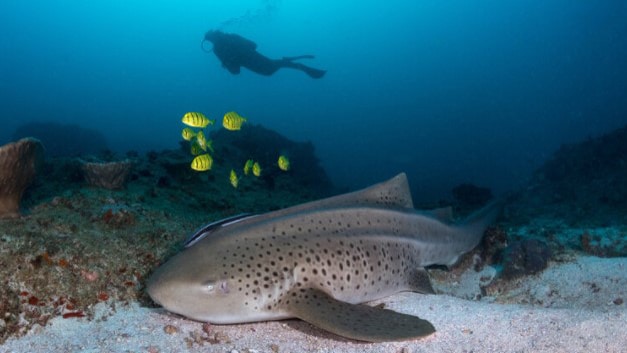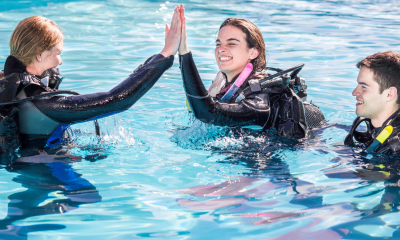Marine Life & Conservation
First study of Zebra Sharks in Africa reveals new hotspot in need of protection

![]() A new study by Marine Megafauna Foundation (MMF), in collaboration with Swansea University and All Out Africa, is the first to describe a population of endangered zebra sharks (also commonly called leopard sharks) in Africa. The study reveals a key global hotspot and potential breeding area. Based on these findings, scientists recommend species-level protection and expansion of marine protected areas, to safeguard this charismatic species.
A new study by Marine Megafauna Foundation (MMF), in collaboration with Swansea University and All Out Africa, is the first to describe a population of endangered zebra sharks (also commonly called leopard sharks) in Africa. The study reveals a key global hotspot and potential breeding area. Based on these findings, scientists recommend species-level protection and expansion of marine protected areas, to safeguard this charismatic species.
The study used structured underwater surveys and identification photos submitted by scuba diver “citizen scientists” to track individual sharks. Additionally, interviews with 100 local fishermen were used to identify potential zebra shark habitats, who are unfortunately most likely to encounter the animals as bycatch in gillnets. Information from underwater surveys created similar distribution maps and habitat modeling also identified new possible hotspot locations that merit future underwater surveys.
Lead author, Saoirse Pottie explains, “This study adds credibility to using a multi-faceted approach to collect baseline data for marine species. When used in combination, fishers’ observations and dive surveys can complement each other. Fisher surveys can collect sightings information at a wider spatial scale than underwater surveys, yet dive surveys are capable of providing more in-depth information on the movement and behavior of individuals.”
The authors hope to inspire other researchers working in data-deficient locations. “This approach could be applied in other regions to highlight areas of interest, prioritize research activities, and inform conservation actions. The inclusion of local knowledge also provides an opportunity to enrich our understanding of social-ecological systems, engage local communities, and make environmental decisions that are more inclusive,” continues Pottie.
Photos taken by scientists and recreational scuba divers between 2010 and 2018 identified 90 individual sharks of both sexes. 38% of sharks were seen in multiple years, indicating an affinity for the area. Over 62% of the sharks were mature. The high frequency of both male and female adult sharks in a small area indicates a breeding area, which is a prime habitat for protection.
While zebra sharks are listed as endangered by the IUCN Red List of Threatened Species, they lack formal protection in Mozambique, and the majority of the suitable zebra shark habitat identified in this study remains unprotected. According to co-author Anna Flam, an MMF scientist, “This is one of the world’s largest identified populations of zebra sharks and we should protect them, otherwise, we could see them disappear, as has happened in parts of Southeast Asia.”
Recreational scuba divers also assisted in data collection. Zebra sharks have unique spot patterns that can be used to identify individuals and track them over time. Identification photos contributed by scuba divers allowed researchers to increase the scope of data capture. Over the course of this study, the researchers helped create the Wildbook for Leopard Sharks, a global online database that allows scuba divers to submit their photos to support research around the world.
Click here to read the full study published in the journal Ocean and Coastal Management.
For more information about the Marine Megafauna Foundation visit their website by clicking here.
Blogs
Invitation from The Ocean Cleanup for San Francisco port call

6 years ago, The Ocean Cleanup set sail for the Great Pacific Garbage Patch with one goal: to develop the technology to be able to relegate the patch to the history books. On 6 September 2024, The Ocean Cleanup fleet returns to San Francisco bringing with it System 03 to announce the next phase of the cleanup of the Great Pacific Garbage Patch and to offer you a chance to view our cleanup system up-close and personal.
We look forward to seeing you there.
To confirm your presence, please RSVP to press@theoceancleanup.com
PROGRAM
Join The Ocean Cleanup as our two iconic ships and the extraction System 03 return to San Francisco, 6 years and over 100 extractions after we set sail, to create and validate the technology needed to rid the oceans of plastic.
Our founder and CEO, Boyan Slat, will announce the next steps for the cleanup of the Great Pacific Garbage Patch. Giving you a chance to view our cleanup system and the plastic extracted.
Hear important news on what’s next in the mission of The Ocean Cleanup as it seeks to make its mission of ridding the world’s oceans of plastic an achievable and realistic goal.
Interviews and vessel tours are available on request.
PRACTICALITIES
Date: September 6, 2024
Press conference: 12 pm (noon)
Location: The Exploratorium (Google Maps)
Pier 15 (Embarcadero at Green Street), San Francisco, CA
Parking: Visit The Exploratorium’s website for details.
RSVP: press@theoceancleanup.com
Video & photo material from several viewing spots around the bay
We look forward to seeing you there!
ABOUT THE OCEAN CLEANUP
The Ocean Cleanup is an international non-profit that develops and scales technologies to rid the world’s oceans of plastic. They aim to achieve this goal through a dual strategy: intercepting in rivers to stop the flow and cleaning up what has already accumulated in the ocean. For the latter, The Ocean Cleanup develops and deploys large-scale systems to efficiently concentrate the plastic for periodic removal. This plastic is tracked and traced to certify claims of origin when recycling it into new products. To curb the tide via rivers, The Ocean Cleanup has developed Interceptor™ Solutions to halt and extract riverine plastic before it reaches the ocean. As of June 2024, the non-profit has collected over 12 million kilograms (26.4 million pounds) of plastic from aquatic ecosystems around the world. Founded in 2013 by Boyan Slat, The Ocean Cleanup now employs a broadly multi-disciplined team of approximately 140. The foundation is headquartered in Rotterdam, the Netherlands, and opened its first regional office in Kuala Lumpur, Malaysia, in 2023.
Find out more about The Ocean Cleanup at www.theoceancleanup.com.
Marine Life & Conservation
SHARK MONTH ARRIVES AT ROYAL WILLIAM YARD, PLYMOUTH

A shark has been spotted approaching Royal William Yard in Plymouth, much to the surprise of swimmers, paddleboarders and onlookers.
With its distinctive dorsal fin cutting through the water, the sizeable shark swam along the coastline, before turning to head inland towards Firestone Arch at Royal William Yard. The appearance drew a crowd, who were captivated for more than an hour by the unusual sight – and it was all caught on video.
The shark is one of many expected sightings at Royal William Yard over the coming weeks… because today marks the start of Shark Month!
In reality, the ‘shark’ spotted along the Plymouth shoreline was actually a custom-made model, created by the team at Royal William Yard and sailed underwater by Caroline Robertson‑Brown from the Shark Trust, who donned scuba diving gear for the occasion.
The stunt took place to launch Shark Month in style and draw attention to the work of the leading international conservation charity, which is based in Britain’s Ocean City. Spectators were reassured that the water was safe and many entered into the spirit of the performance, swimming or sailing alongside the shark.
Shark Month will take place across Royal William Yard throughout July and will feature an extravaganza of art, entertainment and advocacy for everyone to enjoy. The packed programme of events starts with an art exhibition and ends with a trip on paddleboards with shark experts – with everything from a shark quiz to a Jaws screening in between.
Paul Cox, CEO of the Shark Trust, said: “There are often assumptions and misconceptions when it comes to sharks. This was certainly the case with the shark spotted at Royal William Yard! While the British coastline is home to many species of shark, this was not one of them. However, we’re thrilled it caught people’s attention, because seeing a shark is a special and memorable moment. That is precisely why we want to celebrate these incredible creatures, highlight the need for conservation, and ask for help to safeguard their future.”
For more information about Shark Month at Royal William Yard, visit the Shark Trust Website.
Images and video: Jay Stone
-

 Blogs2 months ago
Blogs2 months agoDiving With… Nico, Ocean Earth Travels, Indonesia
-

 News1 month ago
News1 month agoMurex Bangka Announce New Oceanfront Cottages & Beachfront Dining
-

 Blogs2 months ago
Blogs2 months agoA new idea in freediving from RAID
-

 Marine Life & Conservation1 month ago
Marine Life & Conservation1 month agoIceland issue millionaire whale hunter a licence to murder 128 vulnerable fin whales
-

 Marine Life & Conservation2 months ago
Marine Life & Conservation2 months agoThe Shark Trust Great Shark Snapshot is back
-

 News3 months ago
News3 months agoCharting New Waters; NovoScuba Goes Global with the Launch of their Revolutionary Dive Training Agency!
-

 Gear News1 month ago
Gear News1 month agoNew Suunto Ocean – a dive computer and GPS sports watch in one for adventures below and above the surface
-

 Marine Life & Conservation Blogs2 months ago
Marine Life & Conservation Blogs2 months agoBook Review: Plankton
















